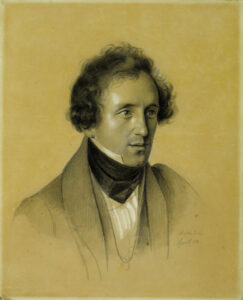 On this day in 1847 Romantic composer, pianist, organist, conductor Felix Mendelssohn died in Leipzig after a series of strokes, age 38. Born on 3 February 1809, in Hamburg.
On this day in 1847 Romantic composer, pianist, organist, conductor Felix Mendelssohn died in Leipzig after a series of strokes, age 38. Born on 3 February 1809, in Hamburg.
Mendelssohn’s compositions include symphonies, concertos, piano music, organ music and chamber music. His best-known works include the overture and incidental music for A Midsummer Night’s Dream, the Italian Symphony, the Scottish Symphony, the oratorio St. Paul, the oratorio Elijah, the overture The Hebrides, the mature Violin Concerto and the String Octet. The melody for the Christmas carol “Hark! The Herald Angels Sing” is also his. Mendelssohn’s Songs Without Words are his most famous solo piano compositions.
Mendelssohn’s grandfather was the renowned Jewish philosopher Moses Mendelssohn, but Felix was initially raised without religion. He was baptised at the age of seven, becoming a Reformed Christian. He was recognised early as a musical prodigy, but his parents were cautious and did not seek to capitalise on his talent. His sister Fanny Mendelssohn received a similar musical education and was a talented composer and pianist in her own right; some of her early songs were published under her brother’s name and her Easter Sonata was for a time mistakenly attributed to him after being lost and rediscovered in the 1970s.
Mendelssohn enjoyed early success in Germany, and revived interest in the music of Johann Sebastian Bach, notably with his performance of the St Matthew Passion in 1829. He became well received in his travels throughout Europe as a composer, conductor and soloist; his ten visits to Britain – during which many of his major works were premiered – form an important part of his adult career. His essentially conservative musical tastes set him apart from more adventurous musical contemporaries such as Franz Liszt, Richard Wagner, Charles-Valentin Alkan and Hector Berlioz. The Leipzig Conservatory, which he founded, became a bastion of this anti-radical outlook. After a long period of relative denigration due to changing musical tastes and antisemitism in the late 19th and early 20th centuries, his creative originality has been re-evaluated. He is now among the most popular composers of the Romantic era.
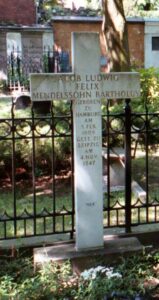 The Final Footprint – Mendelssohn suffered from poor health in the final years of his life, probably aggravated by nervous problems and overwork. A final tour of England left him exhausted and ill, and the death of his sister, Fanny, on 14 May 1847, caused him further distress. Less than six months later, on 4 November, aged 38, Mendelssohn died in Leipzig after a series of strokes. His grandfather Moses, Fanny, and both his parents had all died from similar apoplexies. Although he had been generally meticulous in the management of his affairs, he died intestate.
The Final Footprint – Mendelssohn suffered from poor health in the final years of his life, probably aggravated by nervous problems and overwork. A final tour of England left him exhausted and ill, and the death of his sister, Fanny, on 14 May 1847, caused him further distress. Less than six months later, on 4 November, aged 38, Mendelssohn died in Leipzig after a series of strokes. His grandfather Moses, Fanny, and both his parents had all died from similar apoplexies. Although he had been generally meticulous in the management of his affairs, he died intestate.
Mendelssohn’s funeral was held at the Paulinerkirche, Leipzig, and he was buried at the Dreifaltigkeitsfriedhof I in Berlin-Kreuzberg. The pallbearers included Moscheles, Schumann and Niels Gade. Mendelssohn had once described death, in a letter to a stranger, as a place “where it is to be hoped there is still music, but no more sorrow or partings.”
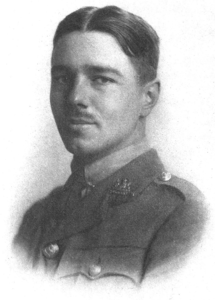 On this day in 1918, English poet and soldier Wilfred Owen was killed in World War I action, at the age of 25, during the crossing of the Sambre–Oise Canal, exactly one week (almost to the hour) before the signing of the Armistice. Born Wilfred Edward Salter Owen on 18 March 1893 at Plas Wilmot, a house in Weston Lane, near Oswestry in Shropshire. One of the leading poets of the First World War, his shocking, realistic war poetry on the horrors of trenches and gas warfare was heavily influenced by his friend and mentor Siegfried Sassoon, and stood in stark contrast both to the public perception of war at the time and to the confidently patriotic verse written by earlier war poets such as Rupert Brooke. Among his best-known works – most of which were published posthumously – are “Dulce et Decorum est”, “Insensibility”, “Anthem for Doomed Youth”, “Futility” and “Strange Meeting”.
On this day in 1918, English poet and soldier Wilfred Owen was killed in World War I action, at the age of 25, during the crossing of the Sambre–Oise Canal, exactly one week (almost to the hour) before the signing of the Armistice. Born Wilfred Edward Salter Owen on 18 March 1893 at Plas Wilmot, a house in Weston Lane, near Oswestry in Shropshire. One of the leading poets of the First World War, his shocking, realistic war poetry on the horrors of trenches and gas warfare was heavily influenced by his friend and mentor Siegfried Sassoon, and stood in stark contrast both to the public perception of war at the time and to the confidently patriotic verse written by earlier war poets such as Rupert Brooke. Among his best-known works – most of which were published posthumously – are “Dulce et Decorum est”, “Insensibility”, “Anthem for Doomed Youth”, “Futility” and “Strange Meeting”.
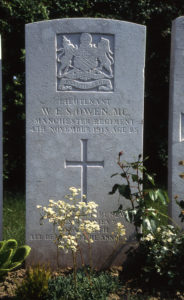 The Final Footprint – His mother received the telegram informing her of his death on Armistice Day, as the church bells were ringing out in celebration. He is interred at the Communal Cemetery in Ors, France.
The Final Footprint – His mother received the telegram informing her of his death on Armistice Day, as the church bells were ringing out in celebration. He is interred at the Communal Cemetery in Ors, France.
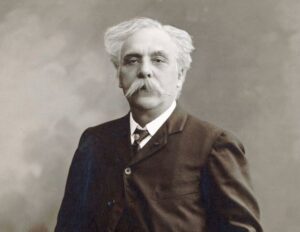 On this day in 1924 composer, organist, pianist and teacher Gabriel Urbain Fauré died in Paris from pneumonia at the age of 79. He was given a state funeral at the Église de la Madeleine and is buried in the Passy Cemetery in Paris.. He was one of the foremost French composers of his generation, and his musical style influenced many 20th-century composers. Among his best-known works are his Pavane, Requiem, Sicilienne, nocturnes for piano and the songs “Après un rêve” and “Clair de lune”.
On this day in 1924 composer, organist, pianist and teacher Gabriel Urbain Fauré died in Paris from pneumonia at the age of 79. He was given a state funeral at the Église de la Madeleine and is buried in the Passy Cemetery in Paris.. He was one of the foremost French composers of his generation, and his musical style influenced many 20th-century composers. Among his best-known works are his Pavane, Requiem, Sicilienne, nocturnes for piano and the songs “Après un rêve” and “Clair de lune”.
Fauré was born into a cultured but not especially musical family. His talent became clear when he was a young boy. At the age of nine, he was sent to the Ecole Niedermeyer music college in Paris, where he was trained to be a church organist and choirmaster. Among his teachers was Camille Saint-Saëns, who became a lifelong friend. After graduating from the college in 1865, Fauré earned a modest living as an organist and teacher, leaving him little time for composition. When he became successful in his middle age, holding the important posts of organist of the Église de la Madeleine and director of the Paris Conservatoire, he still lacked time for composing; he retreated to the countryside in the summer holidays to concentrate on composition. By his last years, he was recognised in France as the leading French composer of his day. An unprecedented national musical tribute was held for him in Paris in 1922, headed by the president of the French Republic. Outside France, Fauré’s music took decades to become widely accepted, except in Britain, where he had many admirers during his lifetime.
Fauré’s music has been described as linking the end of Romanticism with the modernism of the second quarter of the 20th century. When he was born, Chopin was still composing, and by the time of Fauré’s death, jazz and the atonal music of the Second Viennese School were being heard. The Grove Dictionary of Music and Musicians, which describes him as the most advanced composer of his generation in France, notes that his harmonic and melodic innovations influenced the teaching of harmony for later generations. During the last twenty years of his life, he suffered from increasing deafness. In contrast with the charm of his earlier music, his works from this period are sometimes elusive and withdrawn in character, and at other times turbulent and impassioned.
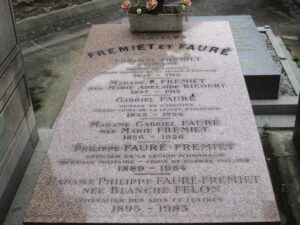 The Final Footprint – He was given a state funeral at the Église de la Madeleine and is buried in the Passy Cemetery in Paris.
The Final Footprint – He was given a state funeral at the Église de la Madeleine and is buried in the Passy Cemetery in Paris.
#RIP #OTD in 1931 cornetist regarded as a key figure in the development of New Orleans style ragtime music, or “jass” (jazz), Charles “Buddy” Bolden died from cerebral arteriosclerosis at the Louisiana State Insane Asylum, Jackson, Louisiana aged 54. Holt Cemetery, New Orleans
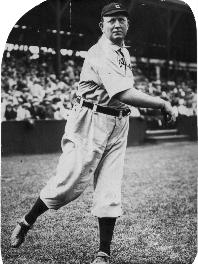 On this day in 1955 baseball Hall of Famer, Cy Young, died on his farm near Newcomerstown, Ohio at the age of 88. Born Denton True Young on 29 March 1867 in Gilmore, Ohio. During his 22-year career he pitched for five different teams; Cleveland Spiders, St. Louis Perfectos, Boston Americans/Red Sox, Cleveland Naps and the Boston Rustlers. He pitched three no hitters and one perfect game, earned one world series ring and still holds five MLB records.
On this day in 1955 baseball Hall of Famer, Cy Young, died on his farm near Newcomerstown, Ohio at the age of 88. Born Denton True Young on 29 March 1867 in Gilmore, Ohio. During his 22-year career he pitched for five different teams; Cleveland Spiders, St. Louis Perfectos, Boston Americans/Red Sox, Cleveland Naps and the Boston Rustlers. He pitched three no hitters and one perfect game, earned one world series ring and still holds five MLB records.
The Final Footprint – Young is interred in Peoli Cemetery in Peoli, Ohio alongside his wife Roba Miller Young. 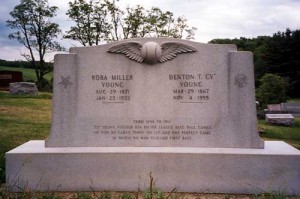 Their graves are marked by a large upright granite marker inscribed as follows: FROM 1890 TO 1911 “CY YOUNG” PITCHED 874 MAJOR LEAGUE BASE BALL GAMES. HE WON 511 GAMES, THREE NO HIT, AND ONE PERFECT GAME IN WHICH NO MAN REACHED FIRST BASE. One year after Young’s death, the Cy Young Award was created to honor the previous season’s best pitcher. The first award was given to Brooklyn’s Don Newcombe. Originally, it was a single award covering the whole of baseball. The honor was divided into two Cy Young Awards in 1967, one for each league. In 1957, Warren Spahn became the first left-handed pitcher to win the award. In 1963, Sandy Koufax became the first pitcher to win the award in a unanimous vote; two years later he became the first multiple winner. In 1974, Mike Marshall won the award, becoming the first relief pitcher to win the award. Roger Clemens currently holds the record for the most awards won, with seven won the most.
Their graves are marked by a large upright granite marker inscribed as follows: FROM 1890 TO 1911 “CY YOUNG” PITCHED 874 MAJOR LEAGUE BASE BALL GAMES. HE WON 511 GAMES, THREE NO HIT, AND ONE PERFECT GAME IN WHICH NO MAN REACHED FIRST BASE. One year after Young’s death, the Cy Young Award was created to honor the previous season’s best pitcher. The first award was given to Brooklyn’s Don Newcombe. Originally, it was a single award covering the whole of baseball. The honor was divided into two Cy Young Awards in 1967, one for each league. In 1957, Warren Spahn became the first left-handed pitcher to win the award. In 1963, Sandy Koufax became the first pitcher to win the award in a unanimous vote; two years later he became the first multiple winner. In 1974, Mike Marshall won the award, becoming the first relief pitcher to win the award. Roger Clemens currently holds the record for the most awards won, with seven won the most.
 On this day in 2008, author, screenwriter, film director and producer Michael Crichton died from lymphoma in Los Angeles at the age of 66. Born John Michael Crichton October 23, 1942 in Chicago. Perhaps best known for his work in the science fiction, thriller, and medical fiction genres.
On this day in 2008, author, screenwriter, film director and producer Michael Crichton died from lymphoma in Los Angeles at the age of 66. Born John Michael Crichton October 23, 1942 in Chicago. Perhaps best known for his work in the science fiction, thriller, and medical fiction genres.
His novels epitomize the techno-thriller genre of literature, often exploring technology and failures of human interaction with it, especially resulting in catastrophes with biotechnology. Many of his novels have medical or scientific underpinnings, reflecting his medical training and scientific background. He wrote, among other works, The Andromeda Strain (1969); Congo(1980); Sphere (1987); Jurassic Park (1990); Rising Sun (1992); Disclosure (1994); The Lost World (1995); Airframe (1996); Timeline (1999); Prey (2002); State of Fear (2004); and Next (2006). Films he wrote and directed included Westworld (1973), Coma (1978), The Great Train Robbery (1979), Looker(1981), and Runaway (1984).
He married five times. Four of the marriages ended in divorce: with Joan Radam (1965–1970), Kathleen St. Johns (1978–1980), Suzanna Childs (1981–1983), and actress Anne-Marie Martin (1987–2003). At the time of his death, Crichton was married to Sherri Alexander (2005–2008).
The Final Footprint
Crichton was cremated.
#RIP #OTD in 2008 ballerina, member of the Choctaw Nation, one of the The Five Moons, five Native American ballerinas from Oklahoma, Rosella Hightower died in her home in Cannes, aged 88. Cimetière Locmaria-Belle Ile, France. Five Moons sculpture, Tulsa OK
Have you planned yours yet?
Follow TFF on twitter @RIPFF

